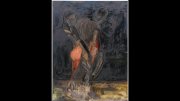What makes an artwork “finished”? That question helps frame Janiva Ellis: Fear Corroded Ape at Harvard’s Carpenter Center for Visual Arts (January 31-April 6). The exhibition highlights 12 paintings that have lain dormant, unfinished, in the New York City artist’s studio. “These are all the persistent, inchoate works which she’s been wrestling with, which is such an interesting category for any artist,” says Dan Byers, the center’s Robinson Family director. “She has not abandoned them, and they have always been asking to be attended to.”
That Ellis has focused on cultural, figurative scenes makes contextual content particularly relevant. She was born in Oakland, California, to a white mother and a black father, and then raised by her mother in Hawaii. She’s known primarily for technicolor canvases depicting experiences of black and biracial people, mostly women, and incorporating religious, landscape, and cartoon elements. Her first solo show in Manhattan, Lick Shot, at 47 Canal, was in 2017; two years later she was included in the Whitney Biennial. Her rise coincided with a “rapacious market for work by black artists working in the figurative manner,” says Byers. Although it was “an overdue acknowledgment,” he adds, “many artists began to feel commodified and tokenized.”
Ellis, he says, was also wary of the trend. Partly in response, she focused more on landscapes and cultural history, using darker or muted colors.
The unfinished works, Byers suggests, in some ways reflect a grappling with marketability and artistic vision, and with the way a “self” is reflected in art. He anticipates that Ellis will likely also take on events “of the last five very tumultuous years for the world, and for the United States.” Thus, much is in play in these paintings making their public debut. “Why do you finish a work? How do you finish a work?” he asks. “And how these specific works will be finished is the question.”









